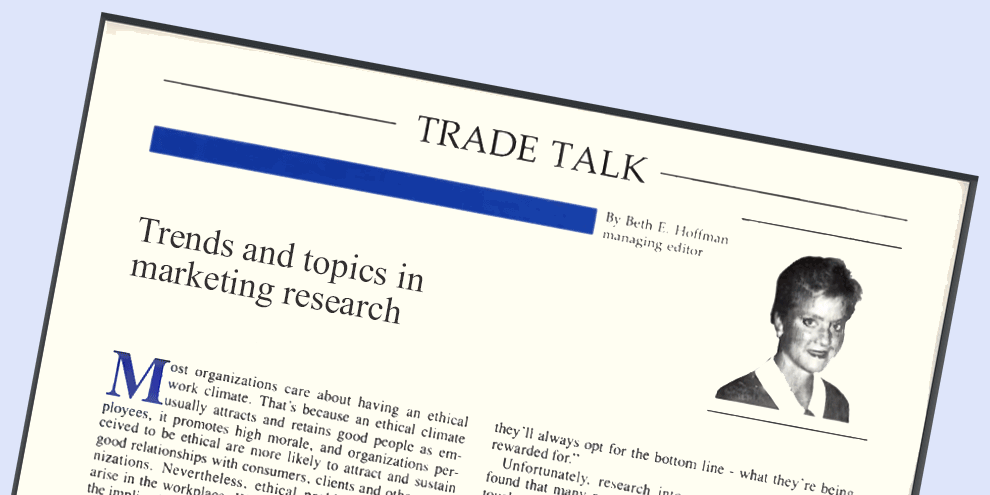Question: What do Coca-Cola, Campbell's, Pepsi-Cola, AT&T, McDonald's, American Express, Kellogg's, IBM, Levi's and Sears have in common?
Answer: Wide recognition and high respectability, making them, in this order, the top 10 most powerful brands in America. A powerful brand is one that is widely recognized as well as highly regarded by those who recognize it, according to the Landor ImagePower Survey™. Conducted by Landor Research, the division of New York and San Francisco-based Landor Associates, the Landor ImagePower Survey™ identifies the 300 most respected brands in the U.S.
According to Landor Research, the ImagePower Survey™ is the first systematic comparative measurement of leading corporate, product and service brands in the U.S. The survey involved interviews with 1,000 American consumers to determine their awareness of, and attitude toward, 675 corporate and consumer brands.
Behind the top 10, here is a sampling of the next most powerful brands mentioned in the survey: Disney, Hershey's, NEC, MasterCard, Tylenol, Kentucky Fried Chicken, Kodak, Windex, Kleenex, Budweiser, 7 Up, Goodyear, Kraft, Malboro, Visa, Cadillac, General Motors, Chevrolet, Xerox, Rolls Royce, Ford, CBS, Minute Maid, Betty Crocker, Colgate, American Airlines, Mercedes, Polaroid, Crest and Wall Street Journal.
"Corporate and brand images today are a matter of economics," says John M. Diefenbach, chief executive of Landor. "Consumers are drowning in product alternatives and media messages. Powerful images are essential to success in the American culture. These images have clear meanings. They reflect positive values. It's a matter of common sense: Consumers turn to familiar and comprehensible images; they reject images that are unrecognizable or incomprehensible."
Diefenbach adds that for more than 30 years, Landor clients have wanted the company to measure the strength of brand images on an industry-by-industry basis. "This quantitative input helps to define our clients' problems and to direct our solutions," says Diefenbach. "The Landor ImagePower Survey™ represents the logical next step; using our expertise to create a 1988 benchmark against which the strength of all corporate and consumer brand images can be measured."
Diefenbach likens corporate and brand images to assets. "Like all assets, they must be consciously and conscientiously managed. The first step toward effective management is valuing those assets and their brand worth potential; that is where the research underlying our ongoing ImagePower Survey™ is most useful to our clients." Some of the other significant findings of the survey:
- Automobiles, television, soft drinks, fast food and credit cards have the highest shares of the American mind.
- Coca-Cola is not just the leading brand in the Landor survey, it is a truly dominant brand, in both recognition and approval. In the survey's ImagePower™ scores, the distance between Coca-Cola (No. 1) and Campbell's (No. 2) is as great a distance as that between Campbell's (No. 2) and Dole (No. 50).
- There is untapped imagepower in some grand old brands that showed sharply higher esteem scores than recognition scores. Not everyone knew them, but the ones who did liked them a lot. These brands include Rolls Royce, Hilton, Harley Davidson, Windex, Rolex, and Arm & Hammer.
- The Japanese beachhead in the American consumer consciousness is surprisingly narrow at this time, limited almost entirely to automobiles and electronics among consumer products. European brands, on the other hand, are well-known across a broad range of product categories, and may become even stronger as European trade barriers are reduced in 1992.
- Numerous well-known brands have real or potential image problems: Their consumer esteem ranks well below what their recognition levels should support. Some leading examples are Playboy, Warner Bros., Greyhound and Weight Watchers.
- Several corporate name changes to acronyms (initials) and tacenyms (meaningless names) produced lower recognition and approval scores than names that preceded them. This was true of USX, NYNEX, and Unisys, among others. But meaningful names like Sara Lee and USAir improved on the scores of their predecessor names. Even taking into account that new names take time to build value, the study indicates that meaningless names are less efficient.
A powerful brand image derives its strength from one or more of the following factors, says director of Landor Research, Stewart Owen:
- Nature of product category: "Strong brands are often associated with high-involvement categories, like automobiles and credit cards," says Owen.
- Product quality: "Strong brands usually do what they do very well. Look at Windex."
- Brand longevity: "It takes time to establish a brand and the first strong brand in an area often builds a lasting lead. Sometimes, the leading brand becomes synonymous with the category itself, as in the case of Kleenex, Xerox or Levi's."
- Advertising and marketing communications: "Many strong brands tell their story both constantly and well; McDonald's and Coca-Cola are excellent examples. And many strong brands have made themselves into super-brands that cover a multitude of products."
- Brand personality: "The strongest brands stand for something; they have a distinctive, well-perceived identity in the consumer's mind. Think of Disney, or Marlboro, or Budweiser, for example."
